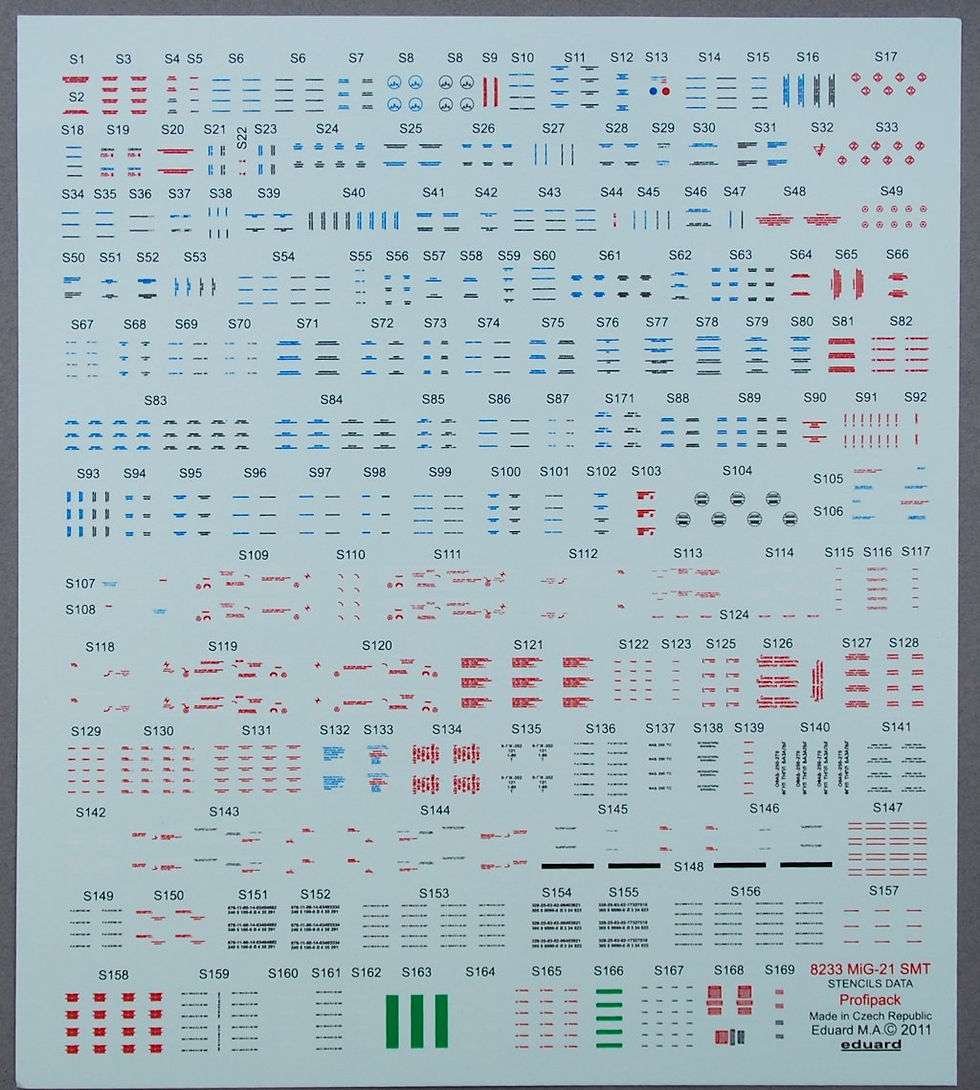Military Model Scene
Robin Buckland's
MiG 21 SMT in 1/48...
...a new Profikit series model from Eduard

Kit reference 8233 is a new Profipack kit from Eduard and provides the chance to build the late model Mig-21, the MT/SMT, known to NATO as the Fishbed-K. I always think of it as the 'humpback' version of the Mig-21. In 1/48 it is quite a good size model.
The build starts with the cockpit floor, installing the main instrument panel, which of course features their lovely pre-coloured etch parts. It is then turned over, as it is also the roof of the nose wheel undercarriage bay. Then you are switched to the back end of the aircraft, and the jet exhaust section of the Turmansky R-13F-300 with afterburner. Then on to more internal details, with the main undercarriage bay, which also features some nice detail elements before moving on to the side consoles for the cockpit. These are again elements which benefit from the pre-coloured etch parts and which are then fitted to the inside walls of the fuselage halves, rather than to the cockpit floor.
With these done, the exhaust section, the cockpit floor, nose cone (and don't forget to add some weights if you want it to stand on its' undercarriage) and a couple of bulkheads the two fuselage halves go together. Then you add the tail and 'hump' to the top of the fuselage. With that on one side, the next stage moves on to the main wings, which uses a single piece part for the lower wing halves and the lower section of the fuselage. This has the interior detail of the main wheel wells to be fitted, and an option to fit the air brakes either open or closed. With the detail in place, the lower wing panel and the internal fuselage undercarriage bay section are both added to the fuselage, along with the tail planes. With that done, fit the upper main wing panels and the ailerons/flaps and wing fences. Then the other detail fittings to the underside of the fuselage plus the nicely detailed undercarriage.
With that done, back to the cockpit, adding the top coaming, the gun sight and the nicely done ejector seat, which also features pre-coloured etch seatbelts. With the seat and canopy in place, along with one or two other final parts, the airframe is done. The next thing to do is choose your armament options and pylons and ejector racks. Included in the box are Eduard's super quality Brassin resin parts for both UB-16 and UB-32 rocket pods, while plastic parts do for the various bombs, missiles and fuel tanks. Another point of visual interest comes with the inclusion of two take-off assistance rocket pods.
With the model built you get to the colours and marking options. What I would mention first though are the airframe and weapons stencilling. There are two full pages in the instruction booklet devoted to just the stencils to add to the pylons and individual weapons. The huge number of them might be viewed differently by modellers. For some, the inclusion of this level of detail is a sign of modern kits and a level of detail we once only dreamed of. For others the large number of these small transfers might be a bit daunting and possibly off-putting while not forgetting there are still dozens more when it comes to the stencils on the main airframe itself, and these take up another full pages in the instructions.
As for the marking options, there are 5. -
-
MiG-21 MT serial number 96.40.14 at Dolgoye Ledovo in Russia, one of only 15 of the MT variant that were produced. This one is currently used as a teaching aid at the Moscow Energy Institute. It has a four colour disruptive camouflage scheme on the upper surfaces and pale blue undersides.
-
MiG-21 MT, serial number 96.40.15, also at Dolgoye Ledovo. This one carries the number of Blue 15 and wears another disruptive camouflage scheme, though this time using four colours providing a much light overall pattern. Undersides are pale blue once more.
-
MiG-21 SMT, 582nd IAP, Chojna Airfield, Poland in the late 19880s. Serial number 500.23.098, this one is currently in a private museum collection in Sweden. It is in the darker four-colour camouflage with pale blue undersides, and carries an ID of Yellow 09.
-
MiG-21 SMT Blue 22 based at Krasnodar Higher Aviation Training Facility in the Soviet Union around 1980. This is overall bare metal with a green nose cone.
-
MiG-21 SMT 296th IAP, in the Soviet Union. Another overall bare metal colour with green nose cone and a nose number of red 92
Thanks to Eduard for this example.
Robin

Box art

Etch detail parts

Resin rocket launchers

Transfers

Stencil Transfers

Notes

Colour and Marking options

Colour and Marking options

Stencil positioning

Stencil positioning